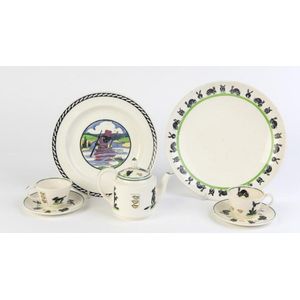Chinese Export Ware Dinner Service for Nizam of Hyderabad
You must be a subscriber, and be logged in to view price and dealer details.
Subscribe Now to view actual auction price for this item
When you subscribe, you have the option of setting the currency in which to display prices to $Au, $US, $NZ or Stg.
- A/f, as Inspected - The letters "A/F" or "as inspected" as part of a description is the cataloguer's shorthand for "all faults" or "as found", meaning the item has some type of damage or deficiency, it is of uncertain date or provenance, and/or that the seller takes no responsibility for the completeness of the item or the accuracy of the description.
- Gilding - Gilding is a method of ornamentation whereby a thin sheet of gold metal is applied to items made of wood, leather, ceramics, glass and silver for decorative purposes.
For furniture including mirrors, the sheet of gold is usually applied over a coating of gesso. Gesso is a mixture of plaster of Paris and gypsum mixed with water and then applied to the carved wooden frames of mirrors and picture frames as a base for applying the gold leaf. After numerous coats of gesso have been applied, allowed to dry and then sanded a coat of "bole", a usually red coloured mixture of clay and glue is brushed on and allowed to dry, after which the gold leaf is applied. Over time parts of the gilding will rub off so the base colour can be seen. In water gilding, this was generally a blue colour, while in oil gilding, the under layer was often yellow. In Victorian times, gilders frequently used red as a pigment beneath the gold leaf.
Metal was often gilded by a process known as fire gilding. Gold mixed with mercury was applied and heated, causing the mercury to evaporate, the long-term effect of which was to kill or disable the craftsman or woman from mercury poisoning. The pursuit of beauty has claimed many victims, not the least of which were the artists who made those pieces so highly sought after today.
This item has been included into following indexes:
- Chinese ceramics, export ware
-
Chinese ceramics, item type
- dinner sets 33
- plates 823
- Nizam of Hyderabad - porcelain and other antiques 14
Visually similar items

A Mintons cup and saucer, circa 1890s, pattern G9910, the cup and saucer of elegant low tapering form decorated with deep blue borders and bands, swags and tendril motifs in gilt relief upon a cream ground; with puce backstamps underside, pattern number an

A set of twenty-seven Wedgwood 'The American sailing Ship' plates, in two sizes - dinner and entree

Royal Doulton 'Sovereign' dinner setting comprising twelve main plates, twelve bread plates, twelve side plates, eleven dessert bowls, eleven saucers, six teacups, an oval dish. Condition fair, one side plate crazed, paint wear to the saucers, two cups res

Seven peices of Wedgwood nursery china, circa 1920, by Daisy Makeig-Jones, stamped Wegwood Etruria England, designed by S.M. Makeig-Jones, plate 34.5 cm diameter
